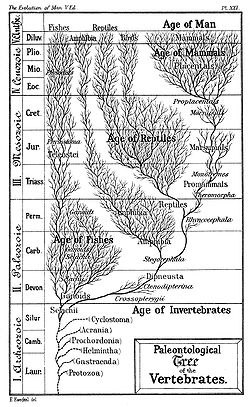
Back مدخل إلى التطور Arabic مقدمه لنظرية التطور ARZ Introducció a l'evolució Catalan Introducción a la evolución Spanish مقدمهای بر فرگشت Persian Introduction à l'évolution (biologie) French क्रम-विकास से परिचय Hindi Uvod u evoluciju Croatian Pengantar evolusi ID ევოლუციური მოძღვრება Georgian

| Part of a series on |
| Evolutionary biology |
|---|
 |
In biology, evolution is the process of change in all forms of life over generations, and evolutionary biology is the study of how evolution occurs. Biological populations evolve through genetic changes that correspond to changes in the organisms' observable traits. Genetic changes include mutations, which are caused by damage or replication errors in organisms' DNA. As the genetic variation of a population drifts randomly over generations, natural selection gradually leads traits to become more or less common based on the relative reproductive success of organisms with those traits.
The age of the Earth is about 4.5 billion years.[1][2][3] The earliest undisputed evidence of life on Earth dates from at least 3.5 billion years ago.[4][5][6] Evolution does not attempt to explain the origin of life (covered instead by abiogenesis), but it does explain how early lifeforms evolved into the complex ecosystem that we see today.[7] Based on the similarities between all present-day organisms, all life on Earth is assumed to have originated through common descent from a last universal ancestor from which all known species have diverged through the process of evolution.[8]
All individuals have hereditary material in the form of genes received from their parents, which they pass on to any offspring. Among offspring there are variations of genes due to the introduction of new genes via random changes called mutations or via reshuffling of existing genes during sexual reproduction.[9][10] The offspring differs from the parent in minor random ways. If those differences are helpful, the offspring is more likely to survive and reproduce. This means that more offspring in the next generation will have that helpful difference and individuals will not have equal chances of reproductive success. In this way, traits that result in organisms being better adapted to their living conditions become more common in descendant populations.[9][10] These differences accumulate resulting in changes within the population. This process is responsible for the many diverse life forms in the world.
The modern understanding of evolution began with the 1859 publication of Charles Darwin's On the Origin of Species. In addition, Gregor Mendel's work with plants helped to explain the hereditary patterns of genetics.[11] Fossil discoveries in palaeontology, advances in population genetics and a global network of scientific research have provided further details into the mechanisms of evolution. Scientists now have a good understanding of the origin of new species (speciation) and have observed the speciation process in the laboratory and in the wild. Evolution is the principal scientific theory that biologists use to understand life and is used in many disciplines, including medicine, psychology, conservation biology, anthropology, forensics, agriculture and other social-cultural applications.
- ^ "Age of the Earth". United States Geological Survey. July 9, 2007. Retrieved 2015-05-29.
- ^ Dalrymple 2001, pp. 205–221
- ^ Manhesa, Gérard; Allègre, Claude J.; Dupréa, Bernard; Hamelin, Bruno (May 1980). "Lead isotope study of basic-ultrabasic layered complexes: Speculations about the age of the earth and primitive mantle characteristics". Earth and Planetary Science Letters. 47 (3): 370–382. Bibcode:1980E&PSL..47..370M. doi:10.1016/0012-821X(80)90024-2.
- ^ Schopf, J. William; Kudryavtsev, Anatoliy B.; Czaja, Andrew D.; Tripathi, Abhishek B. (October 5, 2007). "Evidence of Archean life: Stromatolites and microfossils". Precambrian Research. 158 (3–4): 141–155. Bibcode:2007PreR..158..141S. doi:10.1016/j.precamres.2007.04.009.
- ^ Schopf, J. William (June 29, 2006). "Fossil evidence of Archaean life". Philosophical Transactions of the Royal Society B. 361 (1470): 869–885. doi:10.1098/rstb.2006.1834. PMC 1578735. PMID 16754604.
- ^ Raven & Johnson 2002, p. 68
- ^ "Misconceptions about evolution". Understanding Evolution. University of California, Berkeley. Retrieved 2015-09-26.
- ^ Futuyma 2005a
- ^ a b Gould 2002
- ^ a b Gregory, T. Ryan (June 2009). "Understanding Natural Selection: Essential Concepts and Common Misconceptions". Evolution: Education and Outreach. 2 (2): 156–175. doi:10.1007/s12052-009-0128-1.
- ^ Rhee, Seung Yon. "Gregor Mendel (1822–1884)". Access Excellence. Atlanta, GA: National Health Museum. Archived from the original on 2014-12-27. Retrieved 2015-01-07.
© MMXXIII Rich X Search. We shall prevail. All rights reserved. Rich X Search